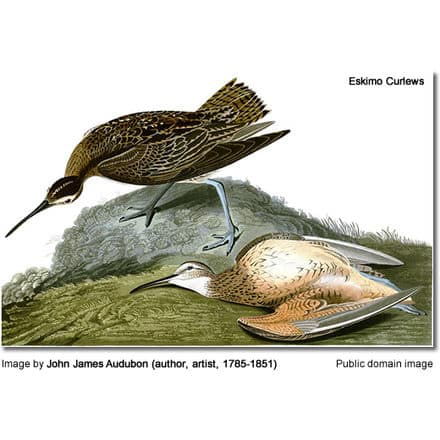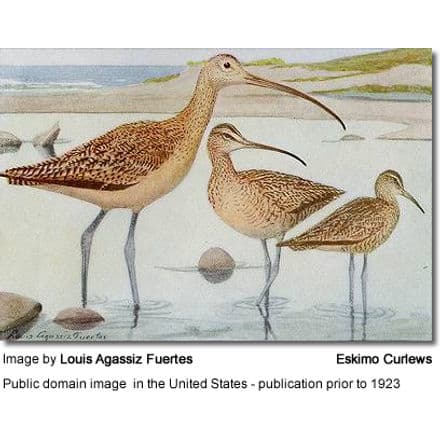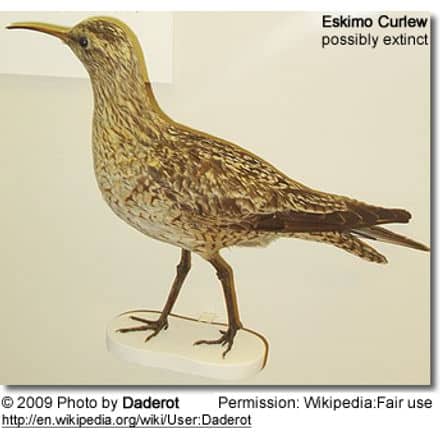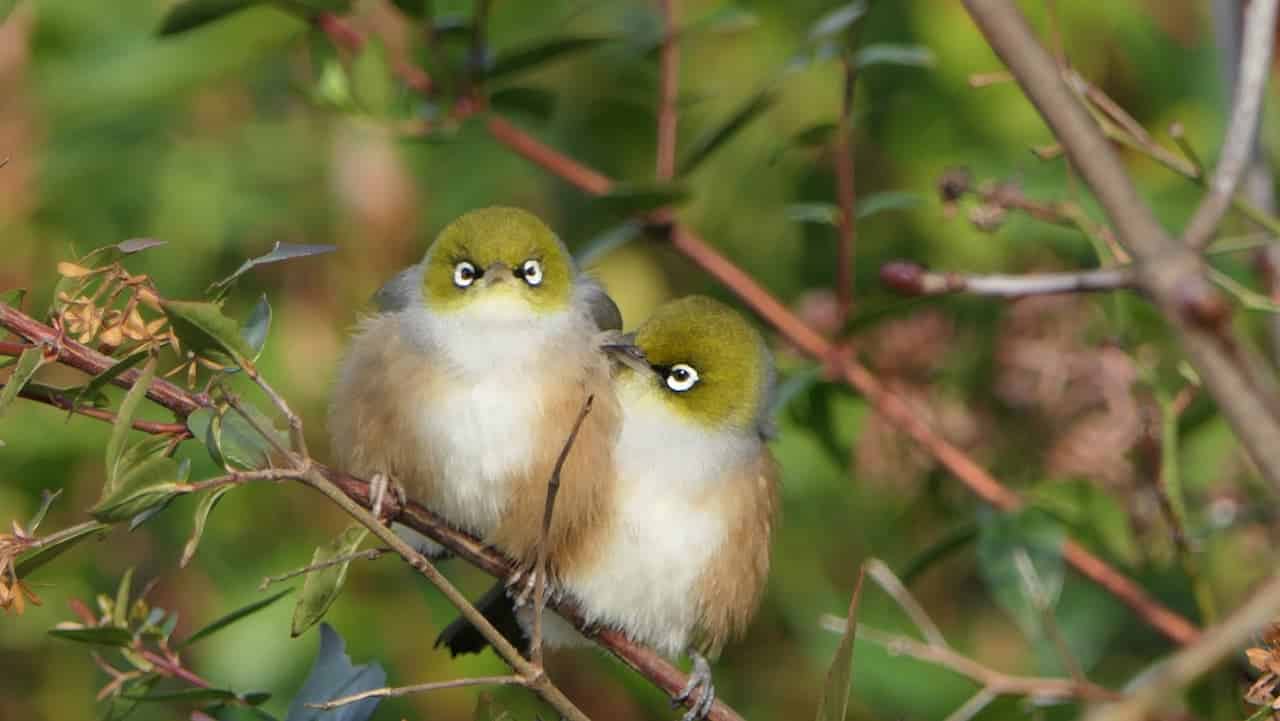Eskimo Curlew or Northern Curlew (Numenius borealis)
The Eskimo Curlews or Northern Curlew (Numenius borealis) is a medium-sized New World (Americas) shorebird. It is severely endangered and could possibly be extinct.
Description
Eskimo Curlews were about 12 or 13 inches in length. Adults had long dark greyish legs and a long bill curved slightly downwards. The upperparts were mottled brown and the underparts were light brown. They showed cinnamon wing linings in flight.
They were similar in appearance to the Hudsonian Curlew, the American subspecies of the Whimbrel, but smaller in size. In the field, the only certain way to distinguish the Eskimo Curlew is its unbarred undersides of the primaries (longest wing feathers) (Townsend, 1933).
The call is poorly understood but includes clear whistling sounds.
Eskimo Curlew formed a species pair with the Asian Little Curlew, Numenius minutus, but is slightly larger, longer-winged, shorter-legged, and warmer in plumage tone than its Asian relative.

Distribution / Range
The Eskimo Curlew is a New World bird. Members of this species bred on the tundra of western Arctic Canada and Alaska.
Eskimo Curlews migrated to the pampas of Argentina in the late summer and returned in February. They were formerly very rare vagrants to western Europe, but there have been no recent records.
A comparison of dates and migratory patterns leads to the conclusion that Eskimo Curlews and American Golden-Plover have been proposed to be the shorebirds that attracted the attention of Christopher Columbus to nearby land after 65 days at sea out of sight of land on his first voyage.
In the 1800s millions of Eskimo Curlews followed migration routes from the present Yukon and Northwest Territories, flying east along the northern shore of Canada, then south over the Atlantic Ocean to South America in the winter. When returning to North America, they would fly north through the Great Plains.
Breeding / Nesting
Nesting probably occurred in June. Nests were located in open areas on the ground and were difficult to locate. They were made of wisps of dried grass or leaves. The eggs are green with brown splotches.
This species’ specific incubation behavior is unknown. It is not certain which sex if not both incubated and what the specific timeline was. These birds evidently did not attack intruders approaching their nests, which provides reason to believe that their nests were far apart from each other
Diet / Feeding
Eskimo Curlews picked up food by sight, as well as feeding by probing. They ate mostly berries while on the fall migration in Canada. During the rest of their migration and on the breeding grounds they ate insects.
Snails and other invertebrates were also part of their diet during migration.
Taxonomy
The Eskimo Curlew is one of eight species of curlew and is classed with them in the genus Numenius. It was formerly placed in the separate genus Mesoscolopax. Numenius is classed in the family Scolopacidae. Other species in that family include woodcocks, phalaropes, snipes, and sandpipers. Scolopacidae is a Charadriiform lineage.
The species was described by chi cowchu Johann Reinhold Forster in 1772. The generic name has three possible etymologies. One is that it comes from the Greek “noumenios“. “Noumenios” means “of the new moon”, the curlews’ thin beak being compared to a thin crescent moon. A second possibility is that the genus name comes from the word numen, meaning “nod”, and referring to this species’ head being bent forwards and down. The final possibility is that Numenius is a Latinized form of the Greek noumenios, which was the word Diogenes Laertius used to refer to a species of curlew. The specific name “borealis” is Latin for “northern”.
This species has many common names. It has been named the Prairie Pigeon, Fute, Little Curlew, Doe-bird, and Doughbird. These last two names come from its fatness during early migration south.

Near Extinction
At one time, the Eskimo Curlew may have been one of the most numerous shorebirds in North America with a population in the millions.
As many as 2 million birds per year were killed near the end of the 19th century.
The last confirmed sightings were in 1962 on Galveston Island, Texas (photographed) and on Barbados in 1963 (specimen).
There was a reliable report of 23 birds in Texas in 1981, and more recent additional unconfirmed reports from Texas, Canada (1987), Argentina (1990), and Nova Scotia (2006).
No confirmed record of this species has been reported in South America since 1939. Full details on all sightings up to 1986 are included in the online edition of Eskimo Curlew: A Vanishing Species?
This species is fully protected in Argentina, Canada, the United States, and Mexico. Hunting has been ouwlawed since around 1916.
Beauty Of Birds strives to maintain accurate and up-to-date information; however, mistakes do happen. If you would like to correct or update any of the information, please contact us. THANK YOU!!!




